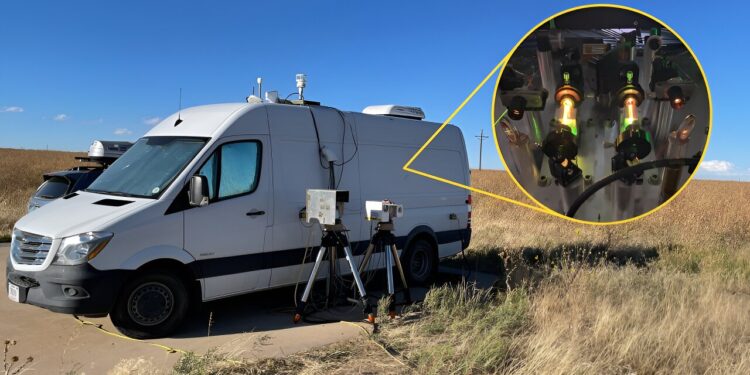A research van housed a mid-infrared laser system (inset) and telescope, which directed light through open air to a mirror several hundred meters away. Credit: K. Cossel/NIST
Researchers at the National Institute of Standards and Technology (NIST) have improved highly precise technology designed to monitor emissions of methane, a critical greenhouse gas, and other trace gases, even in harsh field conditions . Measuring methane emissions and identifying their source is an important step toward reducing them – the goal of the Global Methane Pledge recently signed by more than 150 countries at the 2023 United Nations Climate Change Conference.
NIST’s improved emissions monitoring technology allowed the research team to estimate methane emissions in an approximately 855 square kilometer (330 square mile) area of northern Colorado for two months. A study describing their work is published in the journal Geophysical research letters.
The study, which looked at emissions from two main sources – agriculture and oil and gas production – came to two unexpected conclusions. First, methane emissions from concentrated animal feeding operations (CAFOs) were greater than expected. Second, total emissions from oil and gas production in the study area appear to have plateaued in recent years, despite increasing production.
“Collecting this type of data is useful for policymakers to see how emissions change over time so they can adjust regulations accordingly,” said Kevin Cossel, a researcher at NIST and co-author of the study.
Methane has a global warming potential approximately 30 times greater than carbon dioxide over a 100-year period. Significantly reducing methane emissions can help reduce the risks of climate change. But to manage methane emissions, they must be measured, which presents many technical challenges.
Traditional methods of tracking methane emissions are based on economic activity. For example, one could calculate emissions from a CAFO by multiplying the number of animals by an estimate of the amount of methane emitted by each animal. The NIST method, on the other hand, estimates emissions by directly measuring the change in methane and other gases in the atmosphere.
Precise measurement of emissions by spectroscopy
The NIST setup uses frequency combs, a special type of laser with a broad spectrum of colors or wavelengths to measure gas concentrations along a path through the air. Methane and other gases will absorb specific wavelengths of this light, which will then return to the facility after being reflected by a mirror deployed nearby. A second frequency comb precisely measures the amount of light absorbed at these wavelengths to determine the concentration of these gases and help identify the type of source that produced the emission.
Previous versions of this frequency comb spectrometer have been in use for several years, but the latest version boasts improved robustness, portability and adaptability to various climates.
“We had an early version of this system that we used in the field, but if you look at the data, there’s a lot of downtime when the system isn’t working,” Cossel said. “We rebuilt the system to make it more temperature stable and improve the data collection process.”
Griffin Mead, a researcher at NIST and co-author of the paper, highlighted the system’s resilience under harsh conditions, compared to the limitations of the previous version. “We weren’t taking these measurements in the spring or fall, when the weather is nice,” Mead said. “It was winter in Colorado: it was snowing, raining, hailing, and temperatures outside were below zero. But this new system worked wonderfully in these types of extreme weather conditions, whereas the previous version would not have was able to operate under these conditions.”
The heart of this system, frequency combs built from fiber lasers used in the telecommunications industry, is already commercially available, opening the door for companies and laboratories to replicate this system nationwide.
Beyond methane
The new system not only measures methane, but also other gases, including ethane and ammonia. By simultaneously measuring and analyzing correlations between multiple gases, the study aimed to distinguish contributions from the oil and gas and agricultural sectors, which were then used to improve emissions estimates. This can enable a more complete understanding of the sources and impacts of these pollutants.
The future of emissions monitoring looks bright as Mead and Cossel plan to measure other gases, such as nitrogen oxide emissions from wastewater treatment plants. “Our goal is to further refine the sensitivity and accuracy of the system and expand our search area. We will conduct studies near Salt Lake City over the next several years, which will provide some regional variation,” Cossel said .
As the global community ramps up efforts to reduce methane, this technology could play a crucial role in providing accurate, actionable information to scientists, industry leaders and policymakers.
More information:
Griffin J. Mead et al, Distribution and inventory optimization of methane emissions from the agricultural and energy sector using multi-month trace gas measurements in northern Colorado, Geophysical research letters (2024). DOI: 10.1029/2023GL105973
Provided by National Institute of Standards and Technology
Quote: Team upgrades methane emissions monitoring technology (January 16, 2024) retrieved January 16, 2024 from
This document is subject to copyright. Except for fair use for private study or research purposes, no part may be reproduced without written permission. The content is provided for information only.



